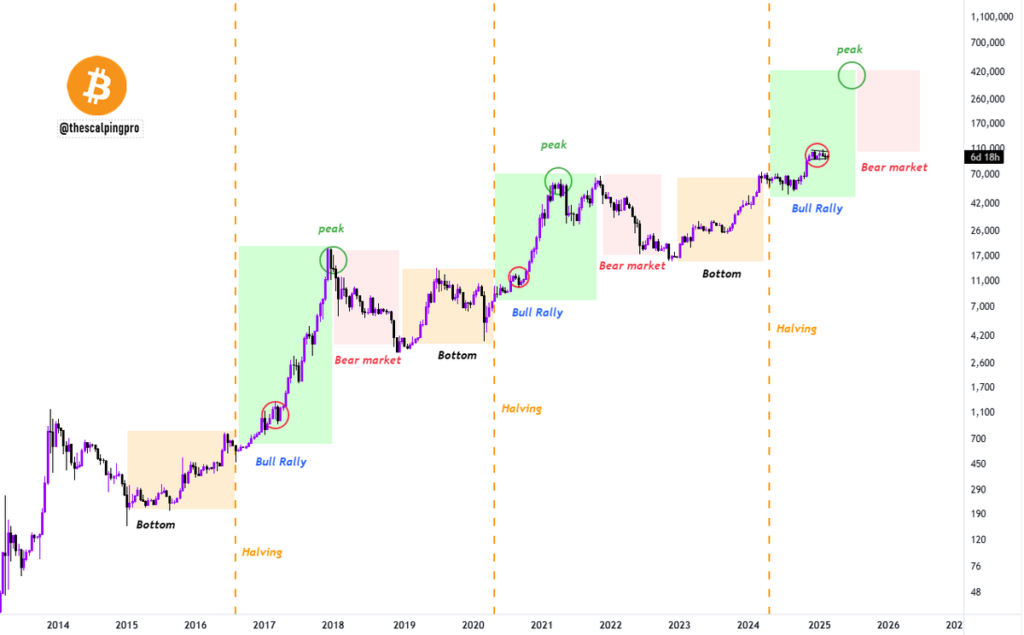
Main Points :
- Bitcoin recently surged near $113,000, reigniting debates on whether a climb to $117,000–$117,000+ is viable amid strong bull indicators.
- Key support/resistance: $112,000–$114,000 is under scrutiny; breaking below $107,000 could spark sharp declines, while reclaiming above $117,000 may signal bullish continuation.
- Analysts diverge sharply: some predict Bitcoin could reach $200,000 within 6–12 months and sustain a bull run through 2027; others foresee a peak at $140,000–$150,000 in 2025.
- Market dynamics are shifting: institutional adoption, regulatory clarity, ETF flows, macroeconomic cycles, and halving-based patterns all influence sentiment.
- For practical users — exploring new cryptos or blockchain applications — the current market offers both speculative opportunity and caution amid evolving valuation paradigms.

1. Recent Market Moves and the $117,000 Question
Bitcoin rallied in early trading to nearly $113,000, supported by renewed buying pressure after dipping to multi-week lows. Analysts now debate whether Bitcoin can breach $117,000, a key technical barrier repeatedly retested.
Bull Perspective:
- TradingView’s BitBull highlights that Bitcoin has recovered above the 100-day EMA (~$110,850), a positive sign for bull formation. Sustaining above this level may open the door to $116,000–$117,000.
Bear Warning:
- Conversely, Roman notes a potential double-top formation. Losing $112,000 fully could expose Bitcoin to a drop toward $102,000.
2. Technical Landscape: Support & Resistance Levels
Technical analysts caution that the battle around $117,000–$115,700 is critical: failure here could invite deeper pullbacks. Meanwhile, a breakdown below $107,000 may trigger mass liquidations, whereas holding ground and climbing back above $117,000 might sustain the bull rhythm.
3. Forecasts & Broader Market Sentiment
Bernstein’s Bullish Forecast:
Bernstein analysts now break from the traditional four-year cycle, predicting a bull run extending into 2027, with Bitcoin potentially reaching $200,000 in the next 6–12 months. They point to regulatory tailwinds (e.g., the Genius Act, a proposed federal Bitcoin reserve, institutional ETF flows) as catalysts.
Skeptics’ View:
- Martin Leinweber argues longer cycles are risky; macro cycles (interest rates, liquidity) now heavily influence Bitcoin. He targets a peak of $140,000–$150,000 in late 2025.
- Alexander Blume highlights institutional involvement and ETF influence as altering historical halving patterns, yet investor psychology (fear/greed) remains unchanged.
4. Options and Short-Term Market Dynamics
A looming $13.8 billion options expiry on August 29 presents a make-or-break moment. Call options total $7.44 billion, puts $6.37 billion, and pricing around $112,000–$114,000 will determine which side – bulls or bears – gets the upper hand.
5. Implications for Crypto Seekers & Blockchain Practitioners
Whether you’re hunting for new cryptos, exploring revenue streams, or pursuing blockchain’s practical use:
- Bullish outlooks suggest fueling innovation and institutional adoption—making blockchain services, DeFi tools, or altcoins attractive bets.
- Bearish or correction scenarios emphasize the need for caution—hedging strategies, defensive capitalization, and evaluating token fundamentals become vital.
Summary
Bitcoin’s climb toward $117,000 underscores a fierce tug-of-war between bullish momentum and bearish caution. Technical indicators — particularly the role of 100‑day EMA and supports at $112,000 and $107,000 — remain litmus tests for future direction. Meanwhile, forecasts diverge sharply: while Bernstein sees Bitcoin potentially surging to $200,000 and sustaining a bull run through 2027, others urge prudence, forecasting a more modest peak by late 2025. The impending $13.8 billion options expiry adds short-term volatility to this complex mix. For blockchain practitioners and new crypto explorers, the current environment offers both promotional prospects and cautionary signals. Ultimately, strategic positioning—balancing opportunity and downside protection—becomes more important than ever.

